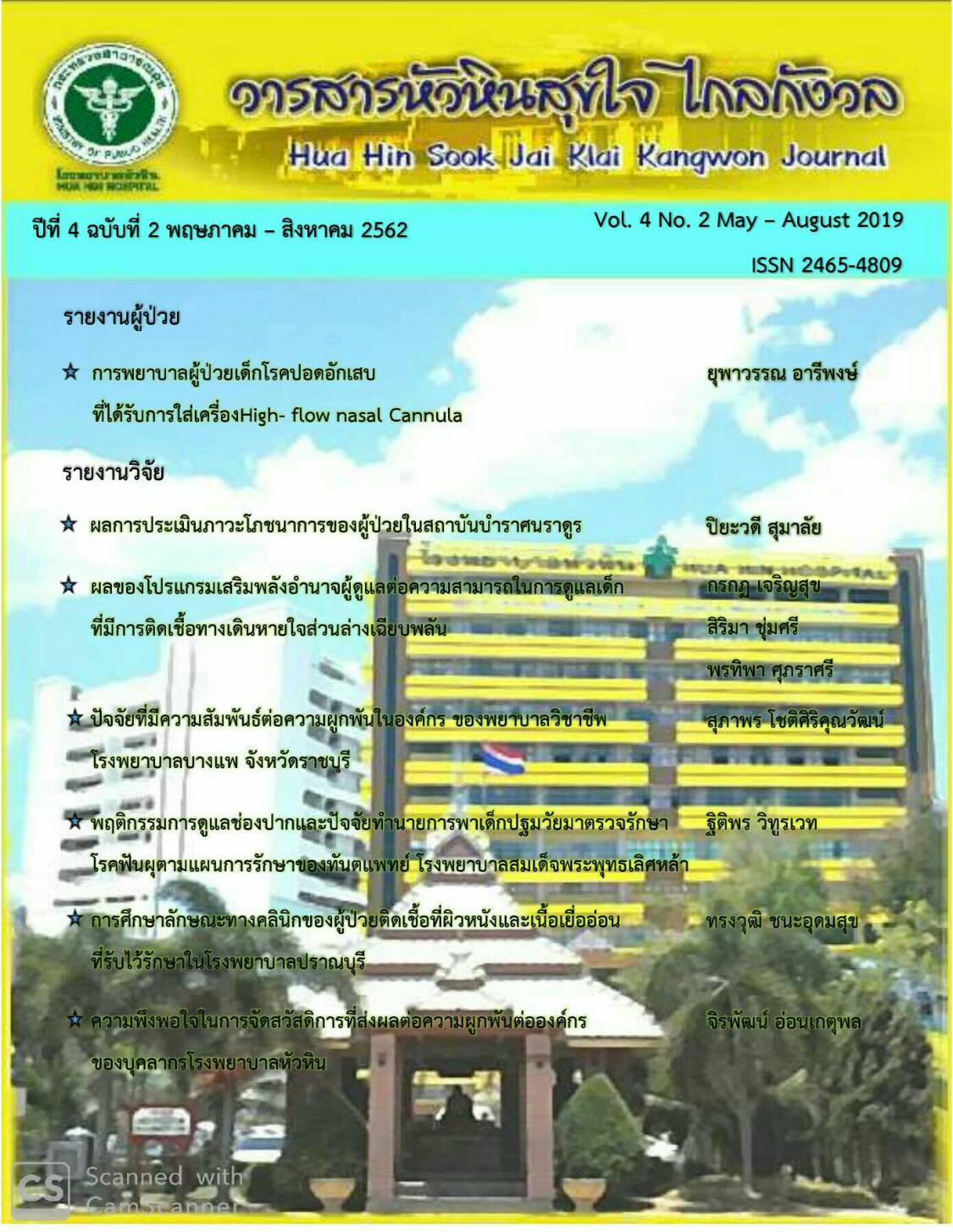Clinical characteristics of skin and soft tissue infection of in-patient at Pranburi hospital
skin and soft tissue infection
Keywords:
skin and soft tissue infectionAbstract
Skin and soft tissues infection is a disease that is common in medical practice. People have the opportunity to have wound or scratches on the skin, causing bacteria in the environment have the opportunity to enter to the wounds lead to infection. However, if receiving improper treatment, the infection can progress and have complications.
Objective: 1. The aim of this study was to explore clinical characteristics in patients infected with skin and soft tissue treated in-patient unit at Pranburi hospital 2. to find the relationship between factors of patients related to the length of hospital stay.
Method of study: retrospective research by collected data after patients infected with skin and soft tissue receiving treatment in the ward Pranburi Hospital Between November 1, 2018 - June 30, 2019. 94 cases were used. The descriptive statistics were presented with the percentage, mean and inferential statistics including analysis, chi square.
Results: The study found 51 male patients, 43 females, with an average age of 52.8 years, with no underlying diseases 34 patients and 60 patients with underlying disease. The cause of infection found that 68 cases of unknown caused, 21 patients were caused by accidents, 5 were bitten by animals, most of which came with symptoms of swelling and redness 62 cases, the remaining were 32 cases of wound or tissue necrosis. The most common in the area were legs about 44 patients, followed by feet about 32 patients, other areas such as the body, arms, hands and buttocks. Most patients have no history of infection in the past. Type of infection, it was found that the infection of the superficial skin or cellulitis 43 cases and 12 cases of abscesses with cellulitis, 14 cases caused by post traumatic wound infection, 13 cases of infected diabetic foot and 8 cases with necrotizing fasciitis. All patients received intravenous antibiotics. There were 45 patients receiving antibiotics alone. Received 11 pus drainage surgery, 38 cases underwent debridement. The results of the treatment were cured from 92 cases. Only 2 people were sent to other hospitals. Patients who received treatment had only one complication, namely hospital acquired pneumonia. There were 3 cases of recurrent infections at the same location. There were no recurrent 91 cases. All patients had an average hospital stay of 5.8 days. From the analysis of the chi square relationship, it was found that the types of infection and tissue debridement were significantly related to the length of hospital stay.
Conclusion: The type of infection and tissue debridement is associated with statistically significant length of hospital days. The results of treatment for skin and soft tissue infections in the district hospital are effective. Fast diagnosis and treatment help reduce the incidence of complications in this group of patients.
References
2. Jenkins TC, Knepper BC, McCollister BD, et al. Failure of outpatient antibiotics among patients hospitalized for acute bacterial skin infections: what is the clinical relevance? Am J Emerg Med 2016;34(6):957–62.
3. Conway EL, Sellick JA, Kurtzhalts K, Mergenhagen KA. Obesity and heart failure as predictors of failure in outpatient skin and soft tissue infections. Antimicrob. Agents Chemother 2017;61(3):1-7.
4. Jenkins TC, Knepper BC, Moore SJ, et al. Antibiotic prescribing practices in a multicenter cohort of patients hospitalized for acute bacterial skin and skin structure infection. Infect Control Hosp Epidemiol 2014;35(10):1241–50.
5. Gibbons JA, Smith HL, Kumar SC, et al. Antimicrobial stewardship in the treatment of skin and soft tissue infections. Am J Infect Control 2017;45(11):1203-1207
6. Almarzoky Abuhussain SS, Burak MA, Adams DK, et al. Variability in emergency medicine provider decisions on hospital admission and antibiotic treatment in a survey study for acute bacterial skin and skin structure infections: opportunities for antimicrobial stewardship education. Open Forum Infect Dis 2018;5(10) : 1-7
7. Walsh TL, Chan L, Konopka CI, et al. Appropriateness of antibiotic management of uncomplicated skin and soft tissue infections in hospitalized adult patients. BMC Infect Dis 2016 Nov 29;16(1):1-8
8. Nathwani D, Corey R, Das AF, et al. Early clinical response as a predictor of late treatment success in patients with acute bacterial skin and skin structure infections: retrospective analysis of 2 randomized controlled trials. Clin Infect Dis 2017;64(2):214–217
9. Caterino JM, Leininger R, Kline DM, et al. Accuracy of current diagnostic criteria for acute bacterial infection in older adults in the emergency department. J Am Geriatr Soc 2017;65(8):1802–9.
10. Richard Brindle, O Martin Williams, Paul Davies, et al. Adjunctive clindamycin for cellulitis: a clinical trial comparing flucloxacillin with or without clindamycin for the treatment of limb cellulitis. BMJ Open 2017;7(3) : 1-9.
11. Tamma PD, Avdic E, Li DX, et al. Association of adverse events with antibiotic use in hospitalized patients. JAMA Intern Med 2017;177(9):1308–15.
12. Soondal Koomar Surrun, Mohammed Tauqeer Ahmed, Sheerin Afzal, et al. The risk factors and clinical characterisitcs of cellulitis: a hospital-based case-control study in Singapore. J Health Res 2009;23(2):81-86.
13. Inghammar M, Rasmussen M, Linder A. Recurrent erysipelas—risk factors and clinical presentation. BMC Infect Dis 2014;14:270.
14. Black N, Schrock JW. Evaluation of skin and soft tissue infection outcomes and admission decisions in emergency department patients. Emerg Med Int 2018;2018:1-7.
Downloads
Published
How to Cite
Issue
Section
License
บทความที่ได้รับการตีพิมพ์ในวารสารหัวหินเวชสาร เป็นลิขสิทธิ์ของโรงพยาบาลหัวหิน
บทความที่ลงพิมพ์ใน วารสารหัวหินเวชสาร ถือว่าเป็นความเห็นส่วนตัวของผู้เขียนคณะบรรณาธิการไม่จำเป็นต้องเห็นด้วย ผู้เขียนต้องรับผิดชอบต่อบทความของตนเอง







